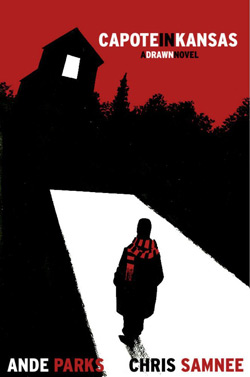 Capote in Kansas by Ande Parks and Chris Samnee is a graphic novel depicting a fictionalized version of author Truman Capote's travels through Middle America researching the murder of the Clutter family for his classic book (new hardcover re-release available July 24, 2013).
Capote in Kansas by Ande Parks and Chris Samnee is a graphic novel depicting a fictionalized version of author Truman Capote's travels through Middle America researching the murder of the Clutter family for his classic book (new hardcover re-release available July 24, 2013).
Truman Capote’s In Cold Blood is widely recognized as a seminal work, establishing true crime as a serious genre that has since earned millions of devotees worldwide. Much has been made of the writing of this groundbreaking novel—for while it was based on true events, there were parts in which the book was definitely more fiction than reality—including several successful movies and essays. Capote In Kansas is a graphic novel that continues the exploration of this terrain, taking similar liberties as the original work to provide an overall effect that, while compelling, is still truthful to the spirit of what actually happened.
We begin in New York City, where Capote is at a dinner party with several other members of the city’s intellectual set. His lover, Jack, is huffy at Capote’s flirtatious attitude towards the waiter, and is only the first of the party to be run off by Capote’s wicked tongue. Once alone with his favorite, Babe Paley, Capote confides in her his dilemma: to go to Kansas to research a brutal multiple-homicide for a non-fiction novel, or to take up The New Yorker on an article covering a chambermaid’s point of view. Paley dismisses the article out of hand, encouraging him to work on what they both know he’d rather do.
Soon enough, he’s in the Midwest with his childhood friend, the soon-to-be famous author Harper Lee. Her unassuming, friendly manner generally placates those put off by Capote’s high-handed New York airs, but not even she can salvage his first meeting with Agent Alvin Dewey, the detective in charge of the investigation. When Dewey asks for Capote’s journalistic credentials as part of the Kansas Bureau of Investigation’s usual protocol for reporters, Capote flippantly replies:
I'm not a reporter. I'm writing a book that may not be done for months. I need personal access to you and your staff. I need to know how this crime affects your community. Frankly, I don't even care if the killers are caught.
Needless to say, such an introduction does little to endear him to Dewey, who was personal friends with the four victims, all members of the Clutter family. Dewey refuses Capote access until the latter can provide some sort of official credential, and things just go downhill from there. An emotionally and physically bruising encounter with the locals at the Clutter funeral later causes Capote to question his own methods and motives.
I wanted to write a great book. Real people… real tragedy. It seemed so simple from a distance. When I saw all of those people in the cemetery, in such pain… just staring at me… I could only think one thing… what gives me the fucking right?
Though supportive, Lee has little time for encouraging self-pity and finally lays down the law: either Capote has to figure out a way to connect with his subjects or pack it in and return to New York to continue writing the short stories he’s celebrated for. Dejected, Capote makes a solo midnight visit to the Clutters’s condemned farmhouse, and has a mystical experience that inspires him to take an entirely new approach to his writing. With renewed purpose, he sets to, humbling himself to Dewey and even earning the confidence of the killers once they’re caught.
It’s fascinating to see how Capote can feel so much for both the victims and their murderers, especially since it was clear at the beginning of the enterprise that his interest was purely subjective, and that he had no intention of letting it develop otherwise. The process by which he further subsumes his ambitions in the need to detail what happened and why, as tribute both to the memories of the Clutters and to the humanity left in their killers, is beautifully portrayed in this smart, sensitive book. Researching In Cold Blood wasn’t the picnic Capote thought it would be, and the change that the experience wreaks in him, as depicted by this graphic novel, is compelling to see. Chris Samnee’s black and white line drawings perfectly complement Ande Parks’ story, especially in the haunting final pages which I accepted as pure invention even as I wanted them to be true.
Doreen Sheridan is a freelance writer living in Washington, D.C. She microblogs on Twitter @dvaleris.
Read all posts by Doreen Sheridan for Criminal Element.

Very nicely written review. I’m now eager to read the book. Thanks.
Thank you! To my shame, I haven’t yet read the original (or seen the movie) so this was a nice introduction.